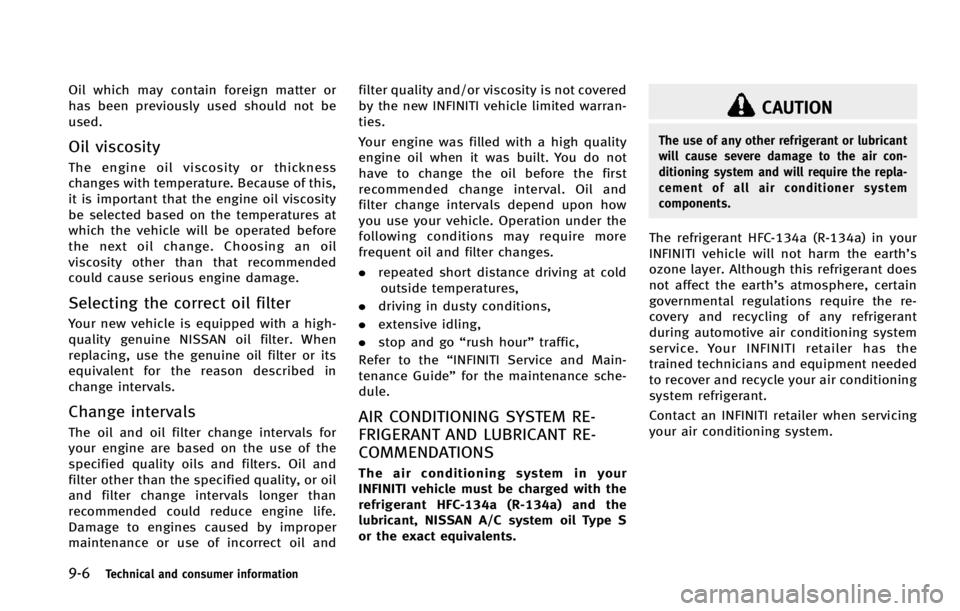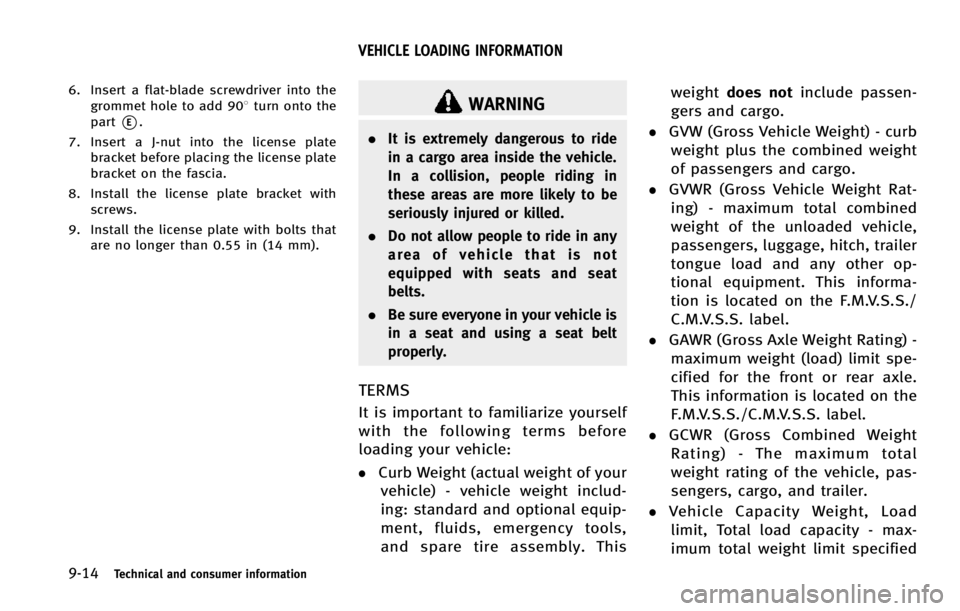INFINITI EX 2013 Owner's Manual
Manufacturer: INFINITI, Model Year: 2013, Model line: EX, Model: INFINITI EX 2013Pages: 498, PDF Size: 2.5 MB
Page 471 of 498

9-6Technical and consumer information
Oil which may contain foreign matter or
has been previously used should not be
used.
Oil viscosity
The engine oil viscosity or thickness
changes with temperature. Because of this,
it is important that the engine oil viscosity
be selected based on the temperatures at
which the vehicle will be operated before
the next oil change. Choosing an oil
viscosity other than that recommended
could cause serious engine damage.
Selecting the correct oil filter
Your new vehicle is equipped with a high-
quality genuine NISSAN oil filter. When
replacing, use the genuine oil filter or its
equivalent for the reason described in
change intervals.
Change intervals
The oil and oil filter change intervals for
your engine are based on the use of the
specified quality oils and filters. Oil and
filter other than the specified quality, or oil
and filter change intervals longer than
recommended could reduce engine life.
Damage to engines caused by improper
maintenance or use of incorrect oil andfilter quality and/or viscosity is not covered
by the new INFINITI vehicle limited warran-
ties.
Your engine was filled with a high quality
engine oil when it was built. You do not
have to change the oil before the first
recommended change interval. Oil and
filter change intervals depend upon how
you use your vehicle. Operation under the
following conditions may require more
frequent oil and filter changes.
.
repeated short distance driving at cold
outside temperatures,
. driving in dusty conditions,
. extensive idling,
. stop and go “rush hour”traffic,
Refer to the “INFINITI Service and Main-
tenance Guide” for the maintenance sche-
dule.AIR CONDITIONING SYSTEM RE-
FRIGERANT AND LUBRICANT RE-
COMMENDATIONS
The air conditioning system in your
INFINITI vehicle must be charged with the
refrigerant HFC-134a (R-134a) and the
lubricant, NISSAN A/C system oil Type S
or the exact equivalents.
CAUTION
The use of any other refrigerant or lubricant
will cause severe damage to the air con-
ditioning system and will require the repla-
cement of all air conditioner system
components.
The refrigerant HFC-134a (R-134a) in your
INFINITI vehicle will not harm the earth’s
ozone layer. Although this refrigerant does
not affect the earth’s atmosphere, certain
governmental regulations require the re-
covery and recycling of any refrigerant
during automotive air conditioning system
service. Your INFINITI retailer has the
trained technicians and equipment needed
to recover and recycle your air conditioning
system refrigerant.
Contact an INFINITI retailer when servicing
your air conditioning system.
Page 472 of 498

ENGINE
ModelVQ37VHR
Type Gasoline, 4-cycle
Cylinder arrangement 6-cylinder, V-slanted at 608
Bore 6Stroke in (mm)3.760
63.385
(95.5 686.0)
Displacement cu in (cm
3)225.54 (3,696)
Firing order 1-2-3-4-5-6
Idle speed rpm
No adjustment is necessary.
Ignition timing
(B.T.D.C.) degree/rpm
Spark plug StandardFXE24HR-11
Spark plug gap (Normal) in (mm)0.043 (1.1)
Camshaft operation Timing chain
This spark ignition system complies with the Canadian standard ICES-002.
STI0425
VQ37VHR engine
Technical and consumer information9-7
SPECIFICATIONS
Page 473 of 498
![INFINITI EX 2013 Owners Manual 9-8Technical and consumer information
WHEELS AND TIRES
Road wheel
TypeSizeOffset in (mm)
Conventional 18
68J
1.85 (47)
19 68J
Spare 17
64T 1.18 (30)
Tire
Type SizePressure PSI (kPa) [Cold]
Conventiona INFINITI EX 2013 Owners Manual 9-8Technical and consumer information
WHEELS AND TIRES
Road wheel
TypeSizeOffset in (mm)
Conventional 18
68J
1.85 (47)
19 68J
Spare 17
64T 1.18 (30)
Tire
Type SizePressure PSI (kPa) [Cold]
Conventiona](/img/42/34934/w960_34934-472.png)
9-8Technical and consumer information
WHEELS AND TIRES
Road wheel
TypeSizeOffset in (mm)
Conventional 18
68J
1.85 (47)
19 68J
Spare 17
64T 1.18 (30)
Tire
Type SizePressure PSI (kPa) [Cold]
Conventional P225/55R18
33 (230)
P245/45R19
Spare (T-type) T165/80R17
60 (420)
T165/80D17
Page 474 of 498

DIMENSIONS
Overall length(with front license plate) in (mm) 182.5 (4,636)
Overall width in (mm)71.0 (1,803)
Overall height (without roof rack)in (mm)62.1 (1,577)*1*3
62.1 (1,578)*4
62.2 (1,579)*2
(with roof rack) 63.0 (1,599)*1
63.0 (1,601)*2
62.9 (1,598)*3
63.0 (1,600)*4
Front tread in (mm)60.4 (1,535)*1*2
60.6 (1,540)*3*4
Rear tread in (mm)
60.8 (1,545)
Wheelbase in (mm)110.2 (2,800)
*1: Two-Wheel Drive (2WD)/18-inch wheel model
*2: Two-Wheel Drive (2WD)/19-inch wheel model
*3: Four-Wheel Drive (AWD)/18-inch wheel model
*4: Four-Wheel Drive (AWD)/19-inch wheel model
Technical and consumer information9-9
Page 475 of 498

9-10Technical and consumer information
If you plan to travel in another country,
you should first find out if the fuel
available is suitable for your vehicle’s
engine.
Using fuel with too low an octane rating
may cause engine damage. All gasoline
vehicles must be operated with unleaded
gasoline. Therefore, avoid taking your
vehicle to areas where appropriate fuel is
not available.
When transferring the registration of your
vehicle to another country, state, province
or district, it may be necessary to modify
the vehicle to meet local laws and regula-
tions.
The laws and regulations for motor vehicle
emission control and safety standards vary
according to the country, state, province or
district; therefore, vehicle specifications
may differ.
When any vehicle is to be taken into
another country, state, province or district
and registered, its modifications, trans-
portation, and registration are the respon-
sibility of the user. INFINITI is not
responsible for any inconvenience that
may result.
STI0431
VEHICLE IDENTIFICATION NUMBER
(VIN) PLATE
The vehicle identification number plate is
attached as shown. This number is the
identification for your vehicle and is used
in the vehicle registration.
STI0492
VEHICLE IDENTIFICATION NUMBER
(chassis number)
The number is stamped as shown in the
engine compartment.
WHEN TRAVELING OR REGISTERING YOUR
VEHICLE IN ANOTHER COUNTRY VEHICLE IDENTIFICATION
Page 476 of 498

STI0509
ENGINE SERIAL NUMBER
The number is stamped on the engine as
shown.
STI0493
F.M.V.S.S./C.M.V.S.S. CERTIFICA-
TION LABEL
The Federal/Canadian Motor Vehicle Safety
Standards (F.M.V.S.S./C.M.V.S.S.) certifica-
tion label is affixed as shown. This label
contains valuable vehicle information, such
as: Gross Vehicle Weight Ratings (GVWR),
Gross Axle Weight Rating (GAWR), month
and year of manufacture, Vehicle Identifi-
cation Number (VIN), etc. Review it care-
fully.
STI0422
EMISSION CONTROL INFORMATION
LABEL
The emission control information label is
attached as shown.
Technical and consumer information9-11
Page 477 of 498

9-12Technical and consumer information
STI0567
TIRE AND LOADING INFORMATION
LABEL
The cold tire pressure is shown on the Tire
and Loading Information label affixed to
the pillar as illustrated.
STI0495
AIR CONDITIONER SPECIFICATION
LABEL
The air conditioner specification label is
attached as shown.
Page 478 of 498

STI0569
Use the following steps to mount the
license plate.
Before mounting the license plate, confirm
that the following parts are enclosed in the
plastic bag.
.License plate bracket
. J-nut 62
. Screw 62
. Screw grommet 62
Only use the recommended mounting
position, otherwise an Intelligent Cruise
Control (ICC) sensor obstruction (if so
equipped) may result.
1. Park the vehicle on flat, level ground.
2. Place the license plate bracket with the positioner
*Afit to the bumper pillar
*Band the side end surface of the
bracket aligned with the bumper
*C.
3. Mark the center of the hole
*Dwith a
felt-tip pen.
4. Carefully drill two pilot holes using a 0.39 in (10 mm) drill bit at the marked
locations. (Be sure that the drill only
goes through the bumper fascia.)
5. Insert grommets into the hole on the fascia.
Technical and consumer information9-13
INSTALLING FRONT LICENSE PLATE
Page 479 of 498

9-14Technical and consumer information
6. Insert a flat-blade screwdriver into thegrommet hole to add 908 turn onto the
part
*E.
7. Insert a J-nut into the license plate bracket before placing the license plate
bracket on the fascia.
8. Install the license plate bracket with screws.
9. Install the license plate with bolts that are no longer than 0.55 in (14 mm).WARNING
.It is extremely dangerous to ride
in a cargo area inside the vehicle.
In a collision, people riding in
these areas are more likely to be
seriously injured or killed.
. Do not allow people to ride in any
area of vehicle that is not
equipped with seats and seat
belts.
. Be sure everyone in your vehicle is
in a seat and using a seat belt
properly.
TERMS
It is important to familiarize yourself
with the following terms before
loading your vehicle:
.Curb Weight (actual weight of your
vehicle) - vehicle weight includ-
ing: standard and optional equip-
ment, fluids, emergency tools,
and spare tire assembly. This weight
does not include passen-
gers and cargo.
.GVW (Gross Vehicle Weight) - curb weight plus the combined weight
of passengers and cargo.
.GVWR (Gross Vehicle Weight Rat-ing) - maximum total combined
weight of the unloaded vehicle,
passengers, luggage, hitch, trailer
tongue load and any other op-
tional equipment. This informa-
tion is located on the F.M.V.S.S./
C.M.V.S.S. label.
.GAWR (Gross Axle Weight Rating) -maximum weight (load) limit spe-
cified for the front or rear axle.
This information is located on the
F.M.V.S.S./C.M.V.S.S. label.
.GCWR (Gross Combined WeightRating) - The maximum total
weight rating of the vehicle, pas-
sengers, cargo, and trailer.
.Vehicle Capacity Weight, Loadlimit, Total load capacity - max-
imum total weight limit specified
VEHICLE LOADING INFORMATION
Page 480 of 498

of the load (passengers and car-
go) for the vehicle. This is the
maximum combined weight of
occupants and cargo that can be
loaded into the vehicle. If the
vehicle is used to tow a trailer,
the trailer tongue weight must be
included as part of the cargo load.
This information is located on the
Tire and Loading Information la-
bel.
.Cargo capacity - permissibleweight of cargo, the weight of
total occupants weight subtracted
from the load limit.STI0365
VEHICLE LOAD CAPACITY
Do not exceed the load limit of your
vehicle shown as “The combined
weight of occupants and cargo” on
the Tire and Loading Information
label. Do not exceed the number of
occupants shown as “Seating Capa-
city” on the Tire and Loading In-
formation label.
To get “the combined weight of
occupants and cargo” , add the
weight of all occupants, then add the total luggage weight. Examples
are shown in the illustration.
Steps for determining correct load
limit
1.Locate the statement
“The com-
bined weight of occupants and
cargo should never exceed XXX kg
or XXX lbs” on your vehicle’ s
placard.
2.Determine the combined weight of
the driver and passengers that
will be riding in your vehicle.
Technical and consumer information9-15